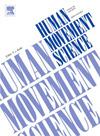Time course of motor learning during human-in-the-loop optimization of a prosthetic foot
IF 1.9
3区 心理学
Q4 NEUROSCIENCES
引用次数: 0
Abstract
Introduction
People with a lower-limb amputation must undergo a process of co-adaptation with a prosthesis to achieve optimal walking performance. Human-in-the-loop optimization could identify optimal prosthetic settings, while also providing insight into the process of motor learning during prosthetic tuning. The aim of the study was to investigate the time course of motor learning of people with transtibial amputation during the human-in-the-loop optimization process of a prosthetic foot, in which the stiffness and alignment were optimized to minimize metabolic cost.
Methods
Ten people with a transtibial amputation underwent an optimization protocol while walking on an instrumented treadmill with an experimental prosthetic foot with tuneable stiffness and alignment. We aimed to minimize the metabolic cost of walking by optimizing the stiffness and alignment, using an evolutionary optimization algorithm consisting of 6 generations of 6 trials. To monitor motor learning throughout the optimization process, motor learning trials with initial standard settings were repeated after each generation. Occurrence of motor learning over time was assessed by comparing metabolic cost and walking biomechanics during motor learning trials.
Results
Metabolic cost during the motor learning trials decreased significantly (≥ 6.8 %) over time (p = 0.01). This reduction in metabolic cost was limited to the first four generations of the optimization process (i.e., 56 min).
Conclusion
Motor learning of people with a transtibial amputation plays a significant role during prosthetic tuning. Motor learning extended over at least 56 min in our human-in-the-loop optimization experiment. Co-adaptation of the user should therefore be taken into account during tuning of prosthetic devices.
人在环优化假肢足运动学习的时间过程
下肢截肢者必须经历一个与假肢共同适应的过程,以达到最佳的行走性能。人在环优化可以识别最佳假肢设置,同时也为假肢调整过程中的运动学习过程提供洞察。本研究的目的是研究在人在环优化假肢足的过程中,经胫骨截肢者的运动学习的时间过程,该过程优化了假肢的刚度和对齐,以最小化代谢成本。方法10例经胫骨截肢患者使用可调节刚度和对齐度的实验性假足在仪器化跑步机上行走时进行优化方案。我们采用6代6次试验的进化优化算法,通过优化步行的刚度和对齐来最小化步行的代谢成本。为了监测整个优化过程中的运动学习,在每代之后重复初始标准设置的运动学习试验。通过比较运动学习试验中的代谢成本和步行生物力学来评估运动学习随时间的发生。结果运动学习试验期间代谢成本随时间显著降低(≥6.8%)(p = 0.01)。这种代谢成本的降低仅限于优化过程的前四代(即56分钟)。结论经胫骨截肢患者的运动学习在假肢调音过程中起着重要作用。在我们的人在循环优化实验中,运动学习至少延长了56分钟。因此,在调整假肢装置时应考虑到用户的共同适应。
本文章由计算机程序翻译,如有差异,请以英文原文为准。
求助全文
约1分钟内获得全文
求助全文
来源期刊

Human Movement Science
医学-神经科学
CiteScore
3.80
自引率
4.80%
发文量
89
审稿时长
42 days
期刊介绍:
Human Movement Science provides a medium for publishing disciplinary and multidisciplinary studies on human movement. It brings together psychological, biomechanical and neurophysiological research on the control, organization and learning of human movement, including the perceptual support of movement. The overarching goal of the journal is to publish articles that help advance theoretical understanding of the control and organization of human movement, as well as changes therein as a function of development, learning and rehabilitation. The nature of the research reported may vary from fundamental theoretical or empirical studies to more applied studies in the fields of, for example, sport, dance and rehabilitation with the proviso that all studies have a distinct theoretical bearing. Also, reviews and meta-studies advancing the understanding of human movement are welcome.
These aims and scope imply that purely descriptive studies are not acceptable, while methodological articles are only acceptable if the methodology in question opens up new vistas in understanding the control and organization of human movement. The same holds for articles on exercise physiology, which in general are not supported, unless they speak to the control and organization of human movement. In general, it is required that the theoretical message of articles published in Human Movement Science is, to a certain extent, innovative and not dismissible as just "more of the same."
 求助内容:
求助内容: 应助结果提醒方式:
应助结果提醒方式:


